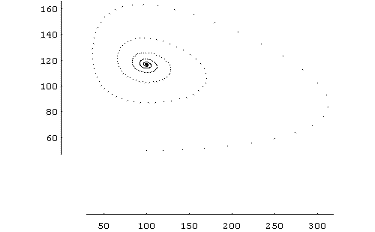
Rnew=R+a*R-b*R^2
where:
Rnew=R+a*R-b*R^2-c*R*F
Fnew=F-d*F+e*R*F
where
 |
In this phase diagram, each pair of values (rabbits, foxes) is represented with a point. As you can see, here the two populations oscillate until they finally reach an equilibrium point. This is a bit boring, and as the logistic equation is part of the system, I expected that more exciting, chaotic things would happen if I played with the values of the constants a, b, c, d and e. |
| After a few experiments, I found a situation in which the two populations followed a cycle that never repeated exactly. Plotting the points during many seasons, I got this wrinkled curve. This is a sure sign of a strange attractor lying near... I didn't take long to find it; you can see two of them below. | 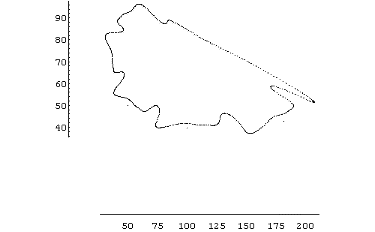 |
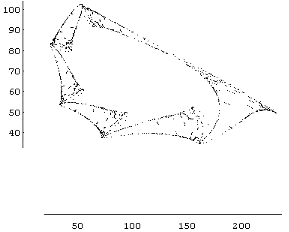
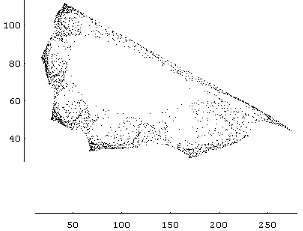
A friend wondered if the Lotke-Volterra equations were realistic enough. The reproduction of foxes shouldn't be substantially different from the reproduction of rabbits (only, perhaps, at a slower rate). But the death rate of foxes should be influenced by the number of rabbits (foxes will starve if there aren't any rabbits, won't they?). Considering this, I changed the second equation to:
Fnew=F-d*F/R+e*F
where
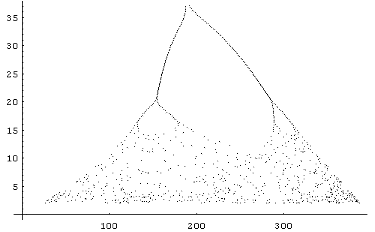 |
This is what I got in my first plot. It looks like a bifurcation diagram, doesn't it? Now, one thing is getting a bifurcation diagram after following carefully the instructions to plot one, and a very different thing is getting a bifurcation diagram from a set of equations that should yield something like a cycle. What on earth is happening here? |
| After studying carefully the situation, I realized that the "rabbits" equation is almost the logistic equation, only with one added term, that depends on the number of foxes. I had given "d" a very small value, which means that the number of foxes just kept increasing, regardless of the number of rabbits. Result: the two equations could be reduced to a logistic equation whose parameters changed slowly with time. So it's not so surprising that I got a bifurcation diagram! Setting d=0, to eliminate feedback between F and R, I could get some fast, good pictures. This method of drawing the bifurcation diagram has its advantages: first, it's faster than the usual one, because there's no need to wait for the transients to pass. Second, it allows us to explore the bifurcation diagram in new ways. For example, plotting only one of every second point, one could see the bifurcation diagram lose one of its branches. In the period-three window, each one of the bifurcations also lose one of the branches! | 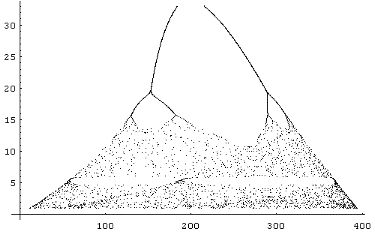
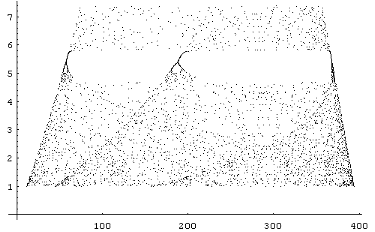
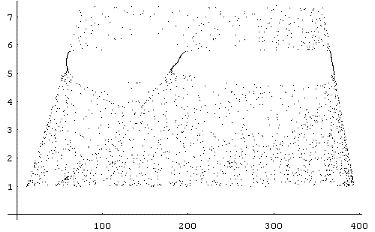 |
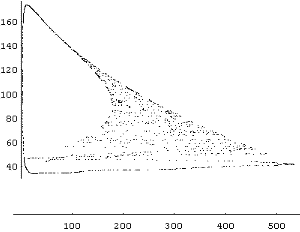

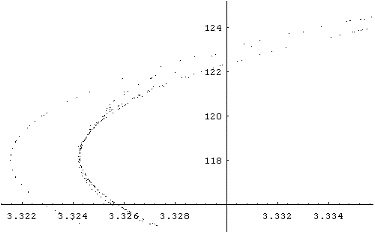 |
And here's the last discovery. I started wondering if that line to the left was what it appeared to be. After all, strange attractors should be fractal, and lines aren't very fractal. So I zoomed and zoomed and - there you are! This is a magnification of that line (it seems very curved because it's much more magnified in the horizontal direction - look at the scale!) |